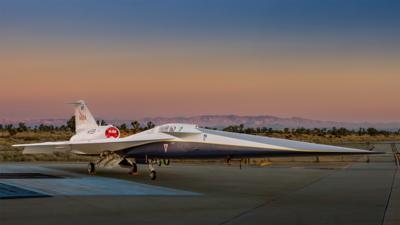Mon, Jan 15, 2024
New Supersonic Prototype Aims to Soften the Blow When Going Beyond Mach 1
No more CGI for the next-gen x-plane from NASA and Lockheed Martin now that the duo has finally debuted the quiet supersonic aircraft live in the metal.

The X-59 Quesst aircraft is a demonstrator to bear out the possibility of supersonic flight without the sonic booms. If successful, the concept will revolutionize public air travel with a whole new niche of high-flying, fast-moving, supersonic aircraft. The Concorde took a swing at the supersonic passenger craft idea, but it ultimately died a slow, expensive market death as its destinations limited its performance to reduce noise on the ground. That apparently ended supersonic pax carriage for good, but new money, new ideas, and fresh materials lie ready and waiting to take another crack at the market.
“This is a major accomplishment made possible only through the hard work and ingenuity from NASA and the entire X-59 team,” said NASA Deputy Administrator Pam Melroy. “In just a few short years we’ve gone from an ambitious concept to reality. NASA’s X-59 will help change the way we travel, bringing us closer together in much less time.”
Melroy was joined by brass from Lockheed and NASA at a ceremony revealing the Quesst demonstrator at the former's Skunk Works facility in Palmdale, California. The aircraft, if successful, won't necessarily be completely free of sonic booms, however. NASA wants to reduce the effect of the supersonic crack with sculpting, shaping, and materials placement that will slough off and delay the transition to supersonic along the body of the aircraft. If successful, the Quesst demonstrator will hit its supersonic cruise of 925 mph or 1.4 mach with a quiet "thump" instead of a loud "boom".
“It’s thrilling to consider the level of ambition behind Quesst and its potential benefits,” said Bob Pearce, associate administrator for aeronautics research at NASA Headquarters in Washington. “NASA will share the data and technology we generate from this one-of-a-kind mission with regulators and with industry. By demonstrating the possibility of quiet commercial supersonic travel over land, we seek to open new commercial markets for U.S. companies and benefit travelers around the world.”
More News
Aero Linx: American Aviation Historical Society AAHS is dedicated to the preservation and dissemination of the rich heritage of American aviation. Our purpose is to collect, preser>[...]
CrewMember (UAS) A person assigned to perform an operational duty. A UAS crewmember includes the remote pilot in command, the person manipulating the controls, and visual observers>[...]
Immediately After The Right Main Tire Contacted The Runway Surface, The Right Main Landing Gear Failed On October 31, 2025, at about 1227 Pacific daylight time, a Maule M-7-235A, N>[...]
Also: IAE Acquires Diamond Trainers, Army Drones, FedEx Pilots Warning, DA62 MPP To Dresden Tech Uni The danger to the flight training industry and our future pilots is clear. Dona>[...]
"On December 3, 2025, at approximately 10:45 a.m., a Thunderbird pilot ejected safely from a F-16C Fighting Falcon aircraft during a training mission over controlled airspace in Ca>[...]
 ANN's Daily Aero-Linx (12.03.25)
ANN's Daily Aero-Linx (12.03.25) ANN's Daily Aero-Term (12.03.25): CrewMember (UAS)
ANN's Daily Aero-Term (12.03.25): CrewMember (UAS) NTSB Prelim: Maule M-7-235A
NTSB Prelim: Maule M-7-235A Airborne-Flight Training 12.04.25: Ldg Fee Danger, Av Mental Health, PC-7 MKX
Airborne-Flight Training 12.04.25: Ldg Fee Danger, Av Mental Health, PC-7 MKX Aero-News: Quote of the Day (12.04.25)
Aero-News: Quote of the Day (12.04.25)



